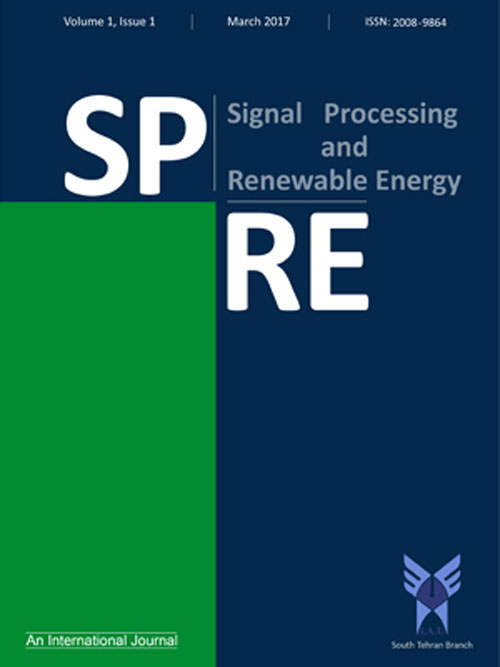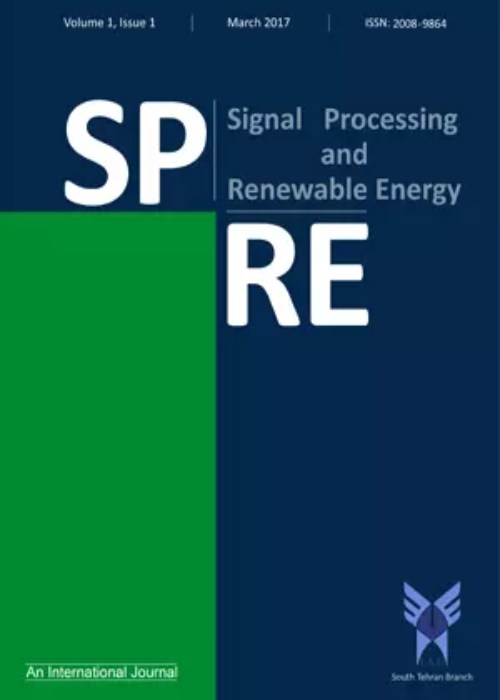فهرست مطالب

Signal Processing and Renewable Energy
Volume:6 Issue: 1, Winter 2022
- تاریخ انتشار: 1400/12/25
- تعداد عناوین: 6
-
Pages 1-16Heart diseases are the leading cause of death worldwide as such the use of an advanced information processing method to diagnose heart disease is one of the most critical fields of medical research. Among various heart diseases, congestive heart failure refers to a difficulty in the heart's pumping, and its symptoms vary depending on the body organ being the most involved in reducing pumping performance. Accordingly, several studies have been conducted to diagnose heart problems using Heart rate variability (HRV) analysis of cardiac signals even though the signals are not accurate enough. The HRV signal extracted from the ECG signal was analyzed to classify the Congestive heart failure’s signals and normal signals in the proposed method. Signal decomposition into a series of subbands was performed using Empirical Wavelets Transform (EWT), and the values were calculated based on different subbands. In this case, the extracted features were classified by the SVM classification method. The method was used to classify normal individuals and those with CHF into two normal or abnormal groups. Finally, by implementing the proposed model and simulating the data of the PhysioNet site, the CHF problem could be automatically detected. The evaluation of the proposed method in comparison to other methods revealed that the proposed method has a significant advantage over other methods, as indicated by the accuracy value of 98.30.Heart diseases are the leading cause of death worldwide as such the use of an advanced information processing method to diagnose heart disease is one of the most critical fields of medical research. Among various heart diseases, congestive heart failure refers to a difficulty in the heart's pumping, and its symptoms vary depending on the body organ being the most involved in reducing pumping performance. Accordingly, several studies have been conducted to diagnose heart problems using Heart rate variability (HRV) analysis of cardiac signals even though the signals are not accurate enough. The HRV signal extracted from the ECG signal was analyzed to classify the Congestive heart failure’s signals and normal signals in the proposed method. Signal decomposition into a series of subbands was performed using Empirical Wavelets Transform (EWT), and the values were calculated based on different subbands. In this case, the extracted features were classified by the SVM classification method. The method was used to classify normal individuals and those with CHF into two normal or abnormal groups. Finally, by implementing the proposed model and simulating the data of the PhysioNet site, the CHF problem could be automatically detected. The evaluation of the proposed method in comparison to other methods revealed that the proposed method has a significant advantage over other methods, as indicated by the accuracy value of 98.30.Keywords: Heart congestion, Heart failure, Empirical wavelets transform
-
Pages 17-37
Nowadays, the use of networked control system (NCS) technologies in modern power systems is on the rise owing to the expansion of electric energy distribution systems and the advent and development of new communication-based technologies. However, the modern network-based energy systems are constructed from some coupled subsystems interconnected via their states and share their information through the communication networks featuring inherent time delays. In this article, an efficacious multi-agent-based cooperative distributed economic model predictive control is developed to damp the frequency fluctuations and reduce the cost of consumed electricity in networked-based smart energy systems by considering communication network inherent delays. In this regard, a buffer-based moving horizon strategy with an estimator is suggested to estimate the own states of every sub-system and the coupled states, i.e., those that their information exchange among sub-systems and their values are not accessible due to communication time delays. Moreover, the boundedness of the estimation error and the stability of the closed-loop system are established by this method. The usability and proficiency of the suggested scheme are proved by applying the developed approach for an interconnected power grid.
Keywords: Networked Control System, Distributed model predictive control, Time delay, Low frequency control, Moving horizon strategy -
Pages 39-64Human brain cells are active even during sleep and communicate through electrical impulses. Electroencephalogram (EEG) signals can be used to extract the correct information from the hu-man brain and classify it with different mental functions. Non-inventiveness, high temporal reso-lution, and relatively low financial cost are the reasons for the use of EEG widely in medical en-gineering research. Extraction of a feature is very important and fundamental for EEG signal classification. In this paper, some of the methods used to extract the features from EEG signals are reviewed. In biomedical research, the classification of EEG signals plays an important role. According to the principles of pattern recognition, the classification process has two stages: fea-ture extraction and classification. This study explains the EEG signal classification. Features are extracted for different bands.Keywords: Electroencephalogram signal, Feature extraction, frequency range
-
Pages 65-81The microgrid consists of several distributed generation units and operates in two modes, connected to the network and autonomous. A good microstructure, especially in autonomous mode, requires a power management strategy. In an island microgrid, there are two methods of centralized and decentralized control. In an island microgrid, the slope changes characteristic of the frequency droop of the source frequency have the greatest effect on the dynamics of the system's response to disturbances in the microgrid. In this paper, the inverter-based microgrid droop control method in island operation mode is analyzed and simulated. The studied system has three scattered sources and six local times. The simulation results are shown using MATLAB software for different modes.Keywords: Island microgrid, Droop Control, inverter based microgrid
-
Pages 83-97Routing with energy consideration has paid enormous attention in the field of wireless sensor networks (WSNs). Aiming at maximizing network lifetime in WSNs, most studies focus on min-imizing energy consumption. Energy is consumed by sensor nodes to perform three important functions such as data sensing, transmitting, and relaying. Also, event-driven WSN applications require minimum end-to-end delay and medium access delay. This paper proposes an energy-efficient fuzzy logic-based fault-tolerant routing protocol (EEFRP) for routing in WSN and min-imizing the energy consumption to a large extent. EEFRP takes two important parameters “resid-ual energy” and “hop-count” into consideration. Simulation results demonstrated that the pro-posed algorithm could achieve better performance in comparison with IEEE 802.15.4 original protocol in terms of end-to-end delay, medium access delay, and fault tolerance, particularly in node failure cases.Routing with energy consideration has paid enormous attention in the field of wireless sensor networks (WSNs). Aiming at maximizing network lifetime in WSNs, most studies focus on min-imizing energy consumption. Energy is consumed by sensor nodes to perform three important functions such as data sensing, transmitting, and relaying. Also, event-driven WSN applications require minimum end-to-end delay and medium access delay. This paper proposes an energy-efficient fuzzy logic-based fault-tolerant routing protocol (EEFRP) for routing in WSN and min-imizing the energy consumption to a large extent. EEFRP takes two important parameters “resid-ual energy” and “hop-count” into consideration. Simulation results demonstrated that the pro-posed algorithm could achieve better performance in comparison with IEEE 802.15.4 original protocol in terms of end-to-end delay, medium access delay, and fault tolerance, particularly in node failure cases.Keywords: Wireless Sensor Networks, Fuzzy-logic, Fault Tolerant, Medium Access Delay
-
Pages 99-111Power system is a nonlinear and temporal variable system. Different parts of the system change at different times and times with changing loads or loss of generators and disturbances. Power system stability and attenuation of low frequency fluctuations are very important. To increase the damping power and stability of the dynamic system, power system stabilizers are used to reduce fluctuations by generating additional control signals for the generator excitation system. In this paper, to improve the stability of the power system dynamic, a power system stabilizer based on synergistic control theory with an excitation system stabilizer according to a simplified nonlinear power system is used. The power system stabilizer has been studied in a single machine system connected to an infinite bus. The results show that the use of power system stabilizer and excita-tion system stabilizer for all nonlinear dynamic systems performs better than synergistic PSS, conventional PSS, and a system without stabilizer.Keywords: Stability, Power system stabilizer (PSS), excitation system stabilizer (ESS), Dynamic Behavior


